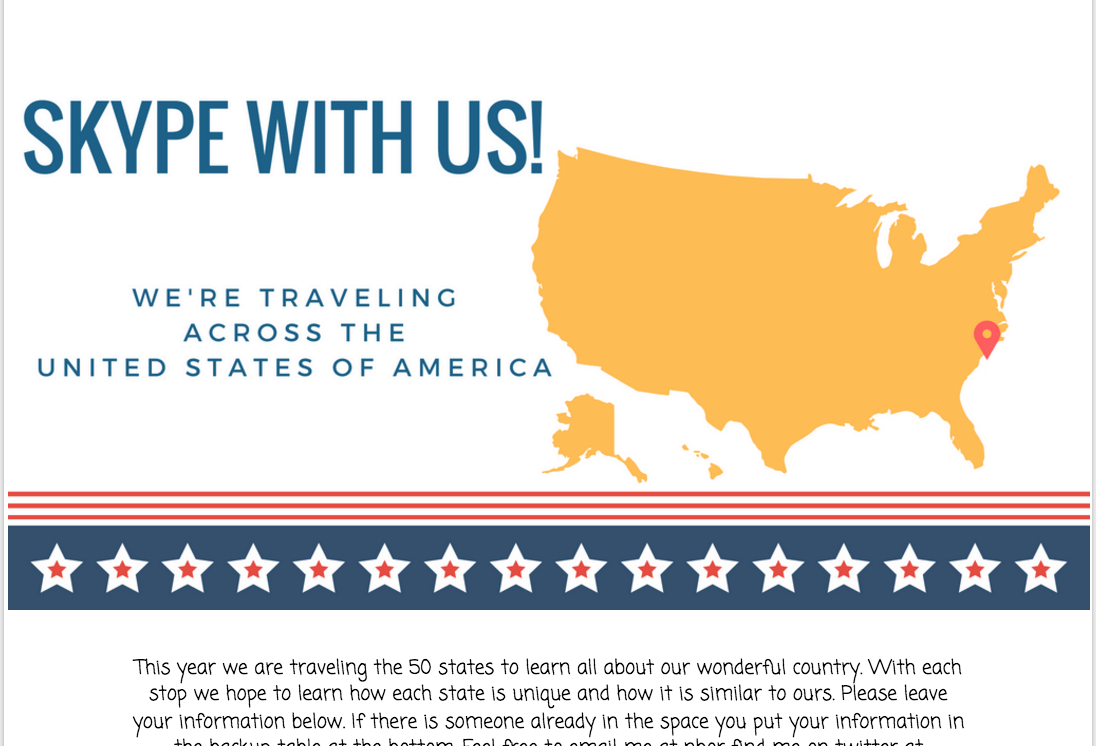- Engagement: The students are using the technology to focus on their learning task by connecting with the students in Germany to get authentic answers to their questions and discuss language. (6/6 Score)
- Enhancement: This project would be difficult to do without technology. The technology enhances the students opportunities to learn from students in Germany in a synchronous way, that could only be done via technology tools. (4/6 Score)
- Extension: The technology allows students to connect their learning of German language and culture to the real world of life and culture in German. (6/6 Score)
- Total Score= 16/18, Exceptional connection between the learning goals and technology used in the project. See here for more information on scoring results.
A German Teacher Creates Authentic Learning by Using Technology to Extend the Classroom Overseas3/30/2017 The German students from L’Anse Creuse High School – North in Macomb, MI, along with teacher James Ekdahl used Twitter and the European educational network of #edchatde to meet and network with Jan Hambsch, English teacher and multimedia consultant from Karlsruhe in Baden-Württemberg Germany. These American students participated in a live video chat with the students from the Josef Durler Schule in Rastatt, Germany to discuss language, culture, and societal questions. The project culminated in a video project where students sent videos about their daily life to each other. Teachers James Ekdahl and Jan Hambsch were also able to meet up in person the summer afterwards when the students from Michigan were visiting Heidelberg, Germany. The use of Twitter and educational professional networking resulted in a project that offered authentic educational connections in a real-world context that engaged students in a powerful way. This project meets the Triple E Framework in the following ways:
0 Comments
In this lesson by Trudy Denton in Westport, Connecticut, students are using statistical analysis to make predictions, hypothesis and conclusions about baseball based on authentic data. Rather than having students use made up data, the teacher took actual data for the students to analyze. She also made certain that there was no one correct answer, that the students would have to use higher-level thinking skills to prove their answer with evidence from the data. The students are using spreadsheets and Fathom software.
Total Score=13/18 (Link to understanding scores) Engagement: Students are working in pairs (co-use), the spreadsheets are specific to the math and students can create graphs and charts based on the spreadsheets to help them dive deeper into the math Score 5/6 Enhancement: The software allowed students to use higher-level thinking skills to analyze the data and meet the learning goals. This could be done with traditional tools but would be very difficult. Score 4/6 Extension: The statistics used come from real world data and students are hypothesizing about a possible real world question. Score 4/6 A second grade teacher, Beverly Ladd, from North Carolina is teaching Geography in a whole new way: Skype! Her classroom is trying to find 50 classes from other states to Skype with and share geography and cultural norms. She set up an open Google doc where classrooms can sign up to do a mystery Skype with her classroom. This is a wonderful way to use technology to extend learning and make it more authentic. Rather than reading about other states, learning from the local "experts" in an inquiry-based way is something that these students will remember, and this would be very difficult to do without the aid of technology!
In this social studies lesson from Digital Promise, students are using email to connect with local and state wide politicians. The students are learning about civic action and engagement by participating in authentic conversations with civic leaders. While the technology is not the most exciting (email), it is serving a strong purpose in meeting the learning goals (to learn how to connect with government leaders and become involved citizens).
In this lesson on Google Earth, elementary teachers (but it could be used with any grade level, K-12) are asking children to research, locate and share their family ancestry using Google Earth tours. The students first research their family history, find out about their immigration paths, and then using the Google Earth tour recording feature, they can record and narrate their families path the U.S. (using pinpoints and authentic family pictures as well).
Engagement: Students can co-engage by creating and researching with their parents or another student. The Google Earth software allows the students to connect with the actual places their families came from and dive deeper into visuals and placing images in exact locations of where they are from. (Score=5) Enhancement: Google Earth allows students to see the places overseas, place authentic images and reflect on their families history through the recording feature. This would be much harder to do without Google Earth (Score=5). Extension: This project is situated in an authentic setting and asks students to use research skills (Score=4). *This lesson could also take full advantage of Ancestry.com to do research on families! Total Triple E Score= about 14 A web-based project called the Michigan Student Caucus is a collaborative project between university students and middle and high school social studies students. The project supports a deep dive into politics, government and advocacy work. University students help to scaffold and support secondary students on their understanding of state government, by using authentic policies and real life issues in Michigan and the state government of Michigan. The secondary students are able to research policies, and even draft their own bill, which they introduce to the Michigan state government at the end of the semester long project. Students form all over the state of Michigan collaborate through the website, and through their co-construction of their own bills and policies based on authentic information from the state of Michigan.
Engagement: The website allows students to co-engage with other students in learning about government and drafting bills. The website helps them focus on the learning goals. Enhancement: University students are able to help scaffold and support the learning through the website discussion boards and private messaging. They can also personalize the learning for the secondary students through the website. Extension: The website allows the students access to work on real world policy. |
AuthorLiz Kolb is a clinical associate professor of education technologies at the University of Michigan in Ann Arbor. She works with over 150 preservice teachers every year on integrating technology into K-12 teaching. Categories
All
More Schools Using Triple E and Articles about #tripleE Kent ISD (MI)
Engaging the Rewired Brain Tech PD Blog Lafayette Jefferson High School (IN) #edtech Blog Noblesville Schools (IN) ISTE Ed Tek Hub West Bloomfield Schools (MI) From Texting to Teaching by Hyler and Hicks Van Buren Elementary School, Janesville (WI) About Education Article eSchoolNews Article Archives
October 2020
|





 RSS Feed
RSS Feed
